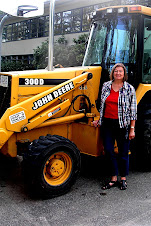Saturday Travel Feature
Seoul Olympic Park, Seoul, Korea
"Seoul (Korean pronunciation: [sʌ.ul] ( listen)), officially the Seoul Special City, is the capital and largest city of the Republic of Korea (South Korea). With a population of over 10 million, it is one of the world's largest cities[4] and is by far the most densely populated city among OECD nations.[5] The Seoul National Capital Area, which includes the Incheon metropolis and most of Gyeonggi province, has 24.5 million inhabitants,[6] and is the world's second largest metropolitan area.[7] Almost half of South Korea's population live in the Seoul National Capital Area, and nearly a quarter in Seoul itself, making it the country's foremost economic, political, and cultural center.
"Seoul is located on the Han River in the center of the Korean Peninsula, and was settled in 18 B.C. when Baekje, one of the Three Kingdoms of Korea, established its capital in what is now south-east Seoul. The city then became the capital of Korea during the Joseon Dynasty and the Korean Empire. The Seoul National Capital Area is home to four UNESCO World Heritage Sites: Changdeokgung, Hwaseong Fortress, Jongmyo Shrine and the Royal Tombs of the Joseon Dynasty.[8]" (See Link .)
"Covering over 1.5 million square meters and the ancient site of the Mongchon Toseong Fortress (with its moat dating back to the early Baekche Kingdom), Olympic Park preserves the spirit of the 1988 Seoul Olympics. The stadiums, arranged in a fan-shaped pattern around the park, were the main stages for the sports events. With extensive grassy fields, sculpture gardens, walking paths, and rest areas, the park is open all day as a multi-purpose area for leisure, sports, and cultural activities." (See Link 1.)
Teaching English in Seoul, Korea was the destination for many Canadian young people during the 1990's. Suzanne Wilson's son and daughter were among those that went for a three month period in this pursuit. During the time that her daughter was there in 1996, Suzanne Wilson visited for six weeks and as a retired ESL teacher also taught in a girls high school classroom and tutored younger children. The photo above was taken on a snowy January day when she took the subway to visit the 1988 Summer Olympic Site. The Pagoda was at the entrance to the site. The photo won a first prize in a 1996 Richmond Museum Photography contest.
Link 1: http://www.lifeinkorea.com/Travel2/seoul/168
Link 2: http://en.wikipedia.org/wiki/Seoul
Seoul Olympic Park, Seoul, Korea
"Seoul (Korean pronunciation: [sʌ.ul] ( listen)), officially the Seoul Special City, is the capital and largest city of the Republic of Korea (South Korea). With a population of over 10 million, it is one of the world's largest cities[4] and is by far the most densely populated city among OECD nations.[5] The Seoul National Capital Area, which includes the Incheon metropolis and most of Gyeonggi province, has 24.5 million inhabitants,[6] and is the world's second largest metropolitan area.[7] Almost half of South Korea's population live in the Seoul National Capital Area, and nearly a quarter in Seoul itself, making it the country's foremost economic, political, and cultural center.
"Seoul is located on the Han River in the center of the Korean Peninsula, and was settled in 18 B.C. when Baekje, one of the Three Kingdoms of Korea, established its capital in what is now south-east Seoul. The city then became the capital of Korea during the Joseon Dynasty and the Korean Empire. The Seoul National Capital Area is home to four UNESCO World Heritage Sites: Changdeokgung, Hwaseong Fortress, Jongmyo Shrine and the Royal Tombs of the Joseon Dynasty.[8]" (See Link .)
"Covering over 1.5 million square meters and the ancient site of the Mongchon Toseong Fortress (with its moat dating back to the early Baekche Kingdom), Olympic Park preserves the spirit of the 1988 Seoul Olympics. The stadiums, arranged in a fan-shaped pattern around the park, were the main stages for the sports events. With extensive grassy fields, sculpture gardens, walking paths, and rest areas, the park is open all day as a multi-purpose area for leisure, sports, and cultural activities." (See Link 1.)
Teaching English in Seoul, Korea was the destination for many Canadian young people during the 1990's. Suzanne Wilson's son and daughter were among those that went for a three month period in this pursuit. During the time that her daughter was there in 1996, Suzanne Wilson visited for six weeks and as a retired ESL teacher also taught in a girls high school classroom and tutored younger children. The photo above was taken on a snowy January day when she took the subway to visit the 1988 Summer Olympic Site. The Pagoda was at the entrance to the site. The photo won a first prize in a 1996 Richmond Museum Photography contest.
Link 1: http://www.lifeinkorea.com/Travel2/seoul/168
Link 2: http://en.wikipedia.org/wiki/Seoul

